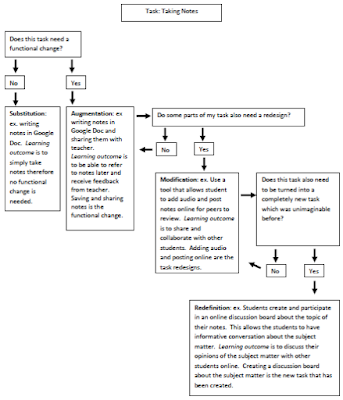The first model of the series is the SAMR model, a four-step model of tech integration designed to improve student outcomes, developed by Dr. Ruben Puentedura .
_______________________________________________________
GENERAL OVERVIEW
 |
| The SAMR Model. (2015). Uploaded by St. Patricks College. Available online at: http://www.stpatricks.tas.edu.au/school-life/elearning/21st-century-learning-copy/the-samar-model/ |
 |
| Questions to Ask. (2015). Uploaded by Patricia Brown. Available online at: https://www.edsurge.com/news/2015-02-06-a-guide-for-bringing-the-samr-model-to-ipads |
Ruben Puentedura on Applying the SAMR Model. (2014). Uploaded to YouTube by Common Sense Education. Available online at: https://youtu.be/W6j8soDYoaw
_______________________________________________________
APPEARANCE IN THE CLASSROOM SETTING
 |
| SAMR Flow Chart. (2015). Uploaded by Erin P. Available online at: http://mrspsclass.blogspot.ca/2015/01/thoughts-on-samr-model.html |
 |
| SAMR Model Thinglink. (2016). Uploaded Kathy Shrock. Available online at: http://www.schrockguide.net/samr.html |
_______________________________________________________
PEDAGOGICAL THEORY & FOUNDATIONS
I found it difficult to accurately critique the pedagogical theory and foundations behind the SAMR model due to a lack of direct information from the author (see paragraph 1 of the next section). The little information I could find is gathered from online videos and slides from Dr. Puentedura's blog (which are mostly diagrams and are out of context without his accompanying presentation).
Influences
- Vannevar Bush
- Douglas Englebert
- Alan Kay
- Seymour Papert (specifically his work with Logo)
Influences
- Vannevar Bush
- Douglas Englebert
- Alan Kay
- Seymour Papert (specifically his work with Logo)
_______________________________________________________
PERSONAL THOUGHTS
I have a few issues with Dr. Puentedura's legitimacy in regards to his work in education:
- I was unable to find any peer-reviewed publications in which he has published the research that went into the development of his model
- His educational background, including his PhD, is in chemistry not pedagogy or didactics
- He does not have any experience teaching in the public school setting (although his model is most-commonly promoted amongst K-12 schools)*
I have seen conflicting information on whether this model is meant to be interpreted as a hierarchy or as a heterarchy. Personally, I am in favour of the latter. Education is very subjective in the sense that different things are going to work for different students, different teachers, different environments, different times of the day; implying that teachers should ALWAYS be striving for the top tier of the model is impractical and not in the best interest of students or educators.
I think the SAMR model does a good job of starting a dialogue between educators regarding how they are using technology with their students. It is also a good starting point for administrators to look at how the technology in their building is being used; if a lot of money is being allocated for new technology that only ever gets used for substitution purposes then maybe staff needs additional support to use the technology in different ways.
Without any published papers regarding his research I am hesitant to comment on Dr. Puentedura's claims regarding student performance and cognitive shifts.
Without any published papers regarding his research I am hesitant to comment on Dr. Puentedura's claims regarding student performance and cognitive shifts.
*Dr. Puentedura does have experience teaching at the post-secondary level